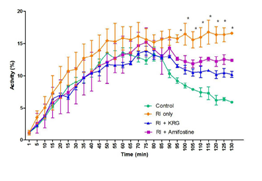글로벌 연구동향
방사선생물학
- [Thyroid.] Protective Effect of Ginseng on Salivary Dysfunction Following Radioiodine Therapy in a Mouse Model.
인하의대 / 김지원, 최정석*
- 출처
- Thyroid.
- 등재일
- 2018 Jul 30. doi: 10.1089/thy.2017.0379. [Epub ahe
- 저널이슈번호
- 내용

그림1. 타액선 기능을 SPECT를 이용하여 평가한 결과

그림2. 타액선 기능을 Salivary flow rate 및 Lag time을 이용하여 평가한 결과
Abstract
BACKGROUND:
Following radioiodine (RI) therapy, oxidative stress is a putative damage mechanism resulting in salivary gland (SG) dysfunction. Since ginseng is a known anti-oxidative herb, we examined the SG radioprotective effects of Korea red ginseng (KRG) in a mouse model, when administered prior to RI.METHODS:
Four-week-old mice (n = 60) were divided into four groups: (1) normal control, (2) RI only treated (0.01 mCi/g, orally), (3) KRG administered (0.2 mg/g, intraperitoneal injection) 0.5 and 24 hours before RI, and (4) amifostine-treated group (0.2 mg/g, intraperitoneally) 0.5 hour before RI. The salivary lag times and flow rates were assessed, and sampled tissues were subjected to histologic examinations including hematoxylin and eosin and immunohistochemical staining. Apoptosis was examined by the terminal deoxynucleotidyl transferase biotin-dUDP nick end labeling (TUNEL) assay, and excretion changes in salivary 99mTc pertechnetate were evaluated by single-photon emission computed tomography.RESULTS:
The body weight of the KRG group was similar to the control group. Salivary lag times and flow rates in the RI + KRG group were faster than in the RI only group. There was no significant intergroup difference in the SG weight. The RI + KRG group exhibited more mucin-containing parenchyma and less fibrotic tissues than the RI only group. Salivary epithelial (aquaporin 5) and myoepithelial (smooth muscle actin) cells of the RI + KRG group were protected from radiation damage. Low 8-OhdG (oxidative stress biomarker) and high superoxide dismutase 2 (reactive oxygen species scavenger) immunostaining reactivity was detected in the RI + KRG group when compared with the RI only group. Fewer apoptotic cells were observed in the RI + KRG or amifostine group compared to the RI only group in the TUNEL assay. The 99mTc pertechnetate excretion level recovered in the KRG group.CONCLUSION:
Pretreatment with KRG before RI therapy is potentially beneficial in protecting against RI-induced salivary dysfunction.
Author informationKim JW1, Kim JM1, Kim SK2, Kim YM1, Choi JS1.
1
1 Department of Otolaryngology, Inha University , College of Medicine, Incheon, Republic of Korea.
2
2 Department of Nuclear Medicine, National Cancer Center , Goyang, Republic of Korea.http://www.rmwebzine.re.kr/newshome/mtnmain.php?mtnkey=articleview&mkey=scatelist&mkey2=76&aid=2757
- 키워드
- animal model; ginseng; radioiodine; salivary gland; thyroid cancer
- 연구소개
- 방사선에 의한 타액선 기능저하는 갑상선 및 두경부 암의 치료 중 흔하게 생기는 합병증이다. 타액선의 기능저하는 구강의 통증 및 입마름증과 함께 다양한 증상을 일으킬 수 있으나 이에 대한 근본적인 치료법은 아직 없다. 본 연구는 Ginseing을 투여한 마우스에서 방사성요오드에 의한 타액선의 기능저하를 예방할 수 있음을 처음으로 증명한 논문이다.
- 덧글달기









